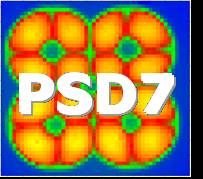Speaker
Mr
Ferran Fernandez Banque
(LLS, Barcelona, Spain)
Description
Micro pattern gas detectors (MPGD) could become suitable devices to
carry out time-resolved X-ray diffraction experiments in the sub-
millisecond time scale at synchrotron radiation facilities. This is
because the small anode-cathode distances in these devices allow
short ion drift times, thus reducing one of the most important count
rate limitations, i.e. space charge effects. This results in
potentially very high local count rates. In addition, the possibility
to manufacture electrode structures with high electrode densities
offers the prospect for excellent spatial resolution. Nevertheless,
these devices are not free of problems. Among other problems: the
build-up of ions in the detector components; the susceptibility of
the materials in the structure to dielectric breakdown, and; the non-
uniformity of response over large areas. Here we present a new MPGD
design we have called Micro Reading Mesh Chamber (MRMC). Its layout
(see Figure 1) is based on a resistive anode (red), support pillars
(green) and a mesh formed by two planes of pick-up strips (yellow and
orange).
Figure 1. View of the mesh and the anode from the window (left),
view of the mesh and the pillars from the anode (center) and lateral
view of the whole structure (right).
In order to improve the cathode signals quality, we use the mesh to
read the avalanche. In this manner the size of the induced charge is
larger than in more conventional geometries. It allows lower
multiplication field intensities, what reduces formation of sparks,
keeping the same detection efficiency. Moreover, a resistive anode
has been designed to quench the sparks at an early stage. With the
aim of preventing charging up, a common problem with GEMs and MPGD
in general, a minimum amount of dielectric material has been used in
the design. The aim has been to avoid dielectric near the drift
paths of the ions.
Finally, the use of one pillar every four cells guarantee good gain
uniformity. In this work we report on the development of this
detector. We show several detailed simulations of every aspect of the
MRMC such as the gas properties, the electron and ion drift
characteristics, a complete model for the multiplication including
the space charge and the resistive layer effects, the signal
formation, the crosstalk between tracks… The optimization process of
the different parameters of the detector (geometry, electric fields,
anode resistivity…) is also shown. Finally, we report on the building
up technique and capabilities.
Primary author
Mr
Ferran Fernandez Banque
(LLS, Barcelona, Spain)
